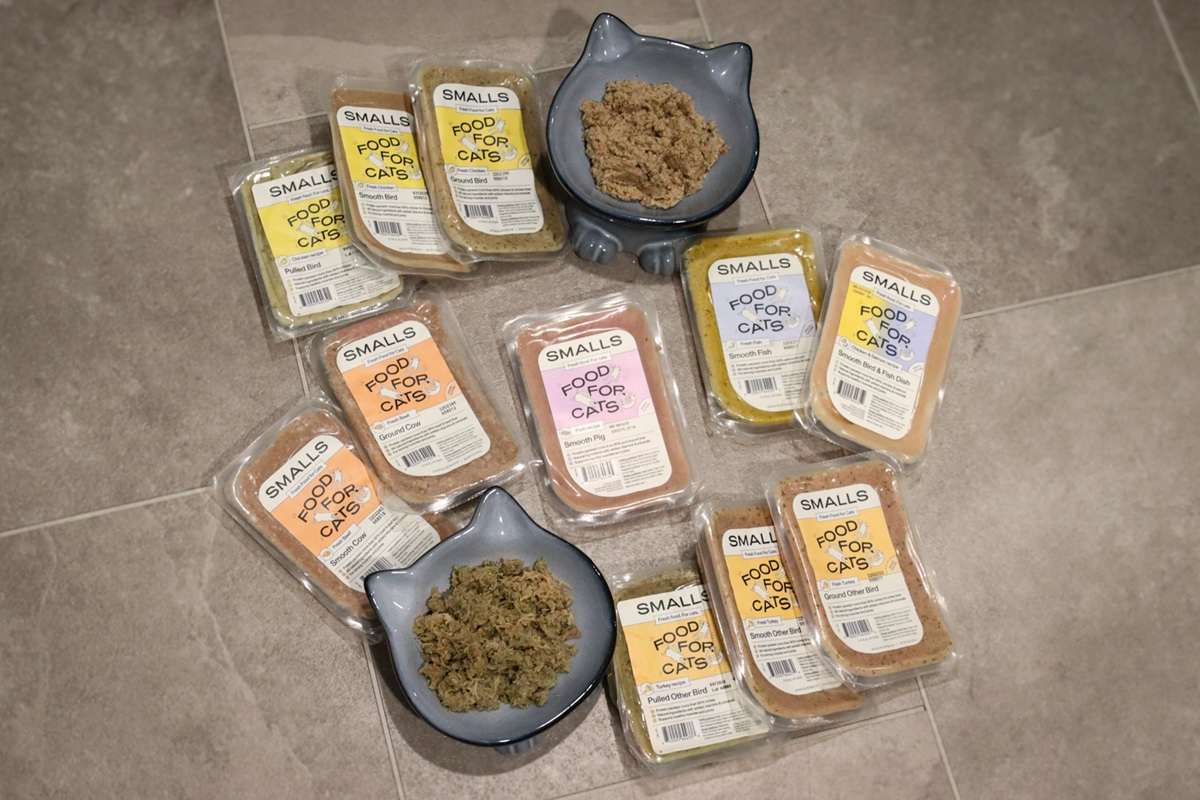
Kirsten McCarthy / Cats.com
This article was sponsored and written by Smalls with review by the Cats.com editorial team.
When it comes to your cats’ food, there is a long list of claims to consider in deciding what ultimately goes in their bowl. As a diligent pet parent, you’ve probably noticed that “human-grade” is a newer label that’s having a moment; but what is human-grade anyway? And is it the right option for your cat?
When considering any new food for your feline friend, it’s important that the food, regardless of quality, is formulated to AAFCO standards, either through meeting established nutritional levels or through animal feeding tests. It’s also a good idea to chat with your vet before making a switch.
s
Here’s what you need to know about human-grade cat food, its benefits, and where to find it.
Defining Quality
The United States Department of Agriculture (USDA) and Food and Drug Administration (FDA) are the agencies responsible for regulating what is acceptable for human consumption, as well as overseeing the manufacturing safety and labeling of pet food. These agencies partner with the Association of American Feed Control Officials (AAFCO) to define regulatory requirements and proper labeling for pet products.
Despite being in existence for over 100 years, the AAFCO didn’t have a definition for feed-grade—or human-grade—food until recently. Very recently. The Association’s conversation around these terms kicked off in late 2015 and didn’t actually wrap up until August 2021.
Unfortunately, their recently released definitions are under copyright, but here’s the gist:
- The USDA defines which ingredients or products are edible or inedible for humans, and based on this, the AAFCO’s slightly out-of-date definition recognizes human-grade as equivalently human-edible.
- The FDA doesn’t explicitly define “feed-grade”, but they are responsible for “making sure food for both people and animals is safe, properly manufactured, and adequately labeled.”But, it’s important to remember that the FDA does not require pre-market review for pet food, and this statement doesn’t help to indicate quality at all.We can also assume that “safe” is being used liberally here, since ingredients like guar gum (a thickening agent), and carrageenan (an emulsifier) are acceptable in pet food, yet studies have shown that, under some circumstances, these may cause inflammation and tumors.
Human-Grade Ingredients

Kirsten McCarthy / Cats.com
Human-grade pet food first starts with human-grade ingredients. As with all cat food, we need to keep in mind that our feline friends are obligate carnivores—they require animal protein to survive.
When it comes to human-grade food, you can be sure that there won’t be mystery meats like “by-products” or “meal”. By-products, while in part are made up of nutritious organs, also contain other low-quality “non-meat” that allows conventional pet food manufacturers to keep recipe protein levels consistent, albeit low quality, and costs low.
Meal is another common ingredient in cat food that vaguely encompasses “tissue”, which is then cooked by the process of “rendering”, or cooking out moisture to create dry, tissue-crisps.
Sound unpleasant? That’s because these industrial scraps would never be seen (or permitted) at a deli counter.
The lack of transparency in the exact ingredients and their quality is something unfortunately permitted in pet food manufacturing. When it comes to human-grade pet food, you will see an ingredient list filled with familiar ingredients like chicken breast or turkey thigh.
Human-grade cat food recipes won’t hide behind “by-products” or “meal”, and will instead proudly tout exact ingredients like chicken hearts, turkey, or beef liver.
Human-Grade Manufacturing
The benefit of human-grade food for cats is more than the quality of ingredients. It’s the safety of the manufacturing process. To label themselves as human-grade, a company has to ensure that (1) all ingredients are safe for human consumption and (2) all food has been prepared, stored, and transported per the legal requirements of food for humans.
As mentioned earlier, the FDA doesn’t require pre-market review for pet foods, but when it comes to human food safety, the FDA regulates non-meat processed food, and the USDA oversees the meat industry, inspecting the pre-market process thoroughly, from the slaughterhouse where the meat was harvested, the kitchen where the meat is cooked, and the facility where the food is stored and prepared for transport.
These additional safety precautions give pet parents peace of mind.
Smalls: The Original Human-Grade Cat Food

Kirsten McCarthy / Cats.com
Looking back on the last 100 years of pet food, it’s hard to imagine how housecats that have evolved from their wild, hunting counterparts, have come to living primarily on a diet of kibble and the occasional canned “wet” food.
Kibble was invented as a necessity to keep pets fed amidst WWII meat and tin rations that crippled the canned pet food industry, but after the restrictions were lifted, pet food manufacturers doubled down on kibble.
Not because it was designed for pets, or even because it was healthy for them, but because it was cheap to make—letting profit margins soar.
In 2017 friends and Smalls co-founders Matt Michaelson and Calvin Bohn discovered the pet food industry’s sordid past, and decided it was time for cats to be fed like the family members they are.
Together, they started making cat food with locally sourced ingredients in their own kitchens. After a few weeks on what is now Smalls Human-Grade Fresh, a cat known internally to the brand as “Ulcer Cat” is a-okay and ulcer-free.
A few short years, a few more Ulcer Cats, and a few million meals later, and Smalls isn’t small-batch anymore, but maintains high-quality human-grade standards.
Pro Tips for Picking the Best Human-Grade Cat Food
When it comes to choosing the best human-grade food for your cat, here’s what you need to know:
Read Carefully
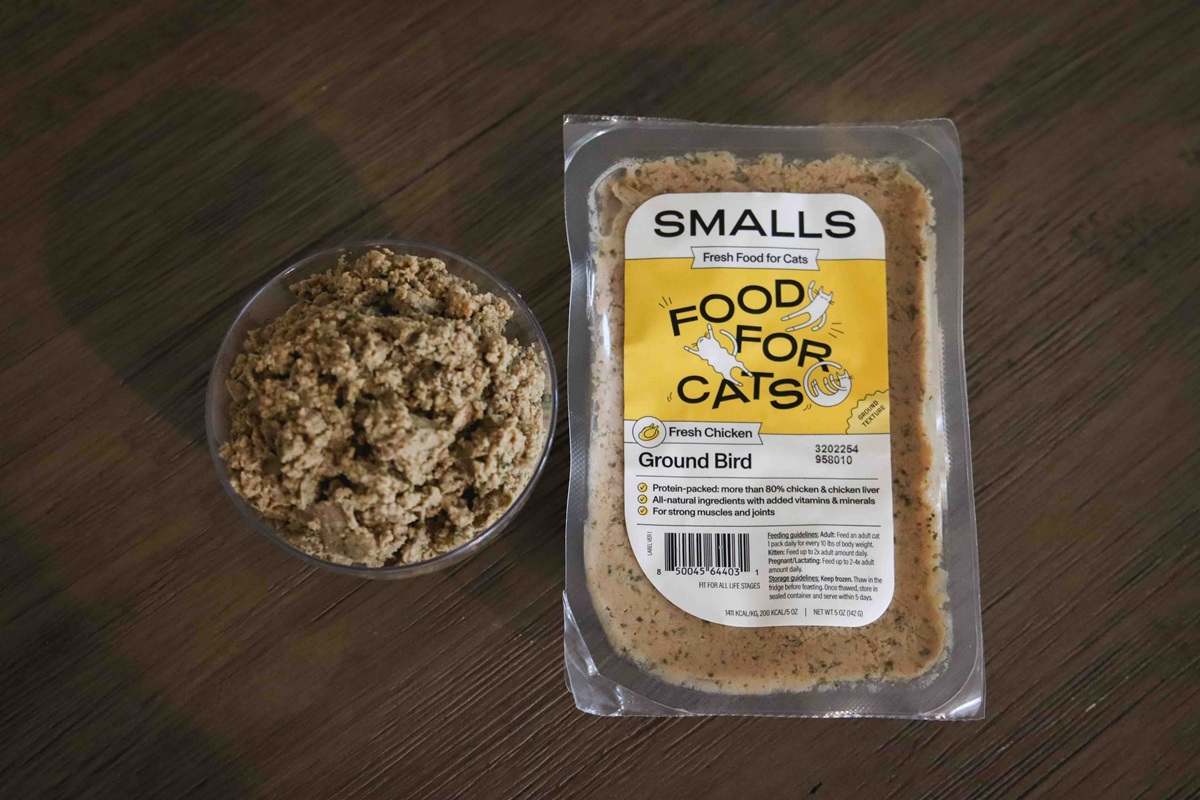
Kirsten McCarthy / Cats.com
Marketers choose their words carefully for a reason. When reading a cat food label, consider “made with human-grade ingredients” as a red flag. This precise phrasing is probably accurate, but when using the word “with” manufacturers are only required to include 3% of that named ingredient in the food.
So “cat food with chicken” may have a lot less chicken in it than “chicken cat food.” Something truly human-grade would contain only human-safe ingredients, and have the labeling practices to back that up.
Human-grade food wouldn’t contain a nondescript “meat by-product” or a meat “meal”, as these vaguely named mystery meats are not classified for human consumption.
Ingredient Quality and Quantity
Human-grade indicates quality, but it’s still important that your cat’s human-grade food is packed with protein, fats, and moisture.
When reading your cat’s food label the first and second ingredients should be an identifiable meat source, ie. turkey thigh and turkey breast instead of “turkey byproduct meal”, but don’t stop reading there.
This list helps to contextualize the nutritional value of the ingredients, which is indicated by the labels Guaranteed Analysis (GA). The GA tells the reader the minimum and maximum amounts of four nutrients: protein, fat, fiber, and moisture, which are essential to cat health. The problem is that the GA doesn’t tell the whole story, so you can do a bit of math (or Googling, we’re not here to judge) to find the recipe’s Dry Matter Basis (DMB) value.
The DMB helps to compare the actual nutrient value of food without the moisture content, and can be found by dividing the GA percentage of a nutrient by (100 – Moisture) and multiplying by 100 to bring us back to a percent.
As obligate carnivores, cats need a protein-rich diet, light on carbohydrates, so an above-average cat food should have more than 50% dry matter protein with less than 20% dry matter carbohydrates.
For reference: Royal Canin’s Adult Instinctive Thin Slices in Gravy has a GA of 10.5% crude protein and 4.6% carbohydrate, but dry matter analysis of 61% crude protein and a whopping 26% carbohydrate. In contrast, Smalls Human-grade Fresh Chicken recipe has a GA of 21.1% protein and 0.4% carbohydrate, with a solid DMA to match. On a dry matter basis, it’s 62.2% protein and 1% carbohydrate.
Human-Grade Standards Throughout
Human-grade cat food companies must adhere to human-quality safety standards. It’s not just important for your cat’s food to have human-grade ingredients, but also be made and stored in a human-grade, USDA-inspected facility.
Smalls believes cat food companies should be more transparent in their process, so they’re leading by example, sharing some exclusive behind the scenes photos from one of their kitchens:
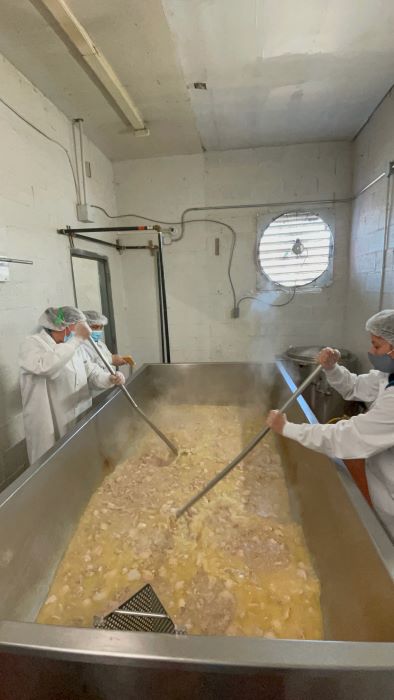
Smalls cat food is slowly cooked and frequently stirred. Mallory Crusta / Cats.com
Smalls Human-grade fresh is slowly cooked and frequently stirred to allow for even heating without stripping natural nutrients.
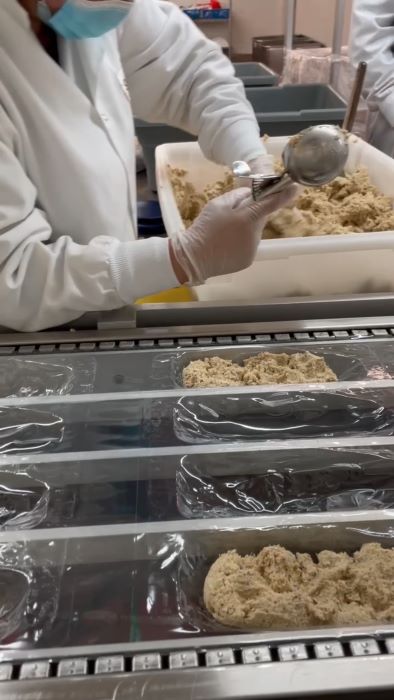
Smalls human-grade cat food is carefully scooped into multi-serving packets, then vacuum-sealed and flash-frozen before shipping. Mallory Crusta / Cats.com
After cooking, Human-grade Fresh food is carefully filled into multi-serving packets that are then vacuum sealed and flash frozen to make the journey from Smalls kitchens to customer’s doorsteps.
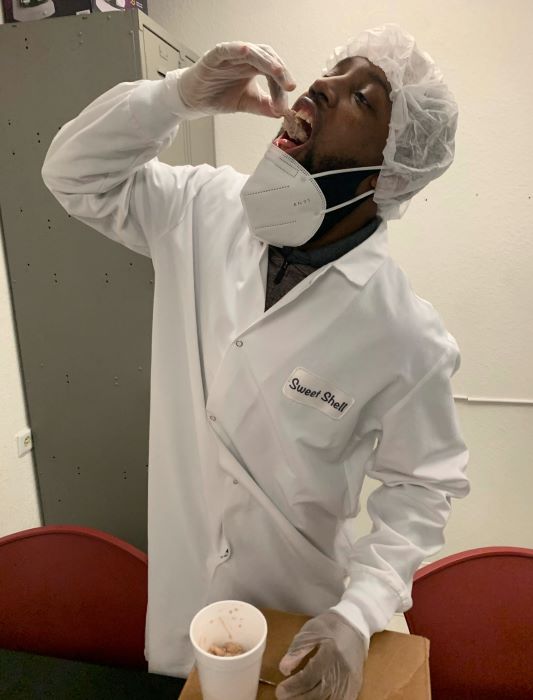
VP of Operations Justin Lewis taste-tests a batch of human-grade cat food before it’s sent out. Mallory Crusta / Cats.com
When we say “human-grade”, we mean it. Our VP of Operations Justin Lewis even taste-tests batches before they ship out.
While his human palate might think that Human-grade Fresh needs some salt, Smalls’ PhD Vet Nutritionists have formulated recipes to be healthy and palatable for your feline friends.
Want to learn more about Smalls cat food? Read our review on Cats.com or visit the Smalls site here.


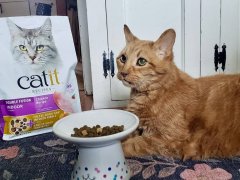



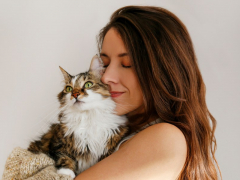

My cat has kidney issues as well as cardiomyopathy, I was reading that I should switch him to human-grade food to improve the quality of his food. But I believe for cats with kidney issues, they need a lower protein diet. What do you recommend in his case?
Nune, this is a controversial area. Not everyone agrees that cats with kidney disease need a low-protein diet; in fact, some emphasize protein quality over quantity, and others just focus on getting sick cats to eat something. Lower protein foods can help to reduce BUN levels and help your cat feel better, but if the food isn’t palatable, you won’t get the benefits, anyway. Additionally, a heavily protein-restricted diet will only contribute to the muscle wasting common among cats with kidney disease. I would recommend a combination of a good human-grade food (high in protein) and a lower-protein kidney diet or a vet-formulated human-grade food intended for kidney disease. This last option will be a bit harder to get your hands on, and you may need to work directly with a veterinary nutritionist to create something that fits your cat’s needs. I hope this helps.
I AM CONSIDERING SWITCHING MY CAT FROM CANNED CAT FOOD (5.5 oz.) TO RAW FREEZE DRIED. IN THE TRANSITIONING PROCESS HOW DO I FIGURE OUT WHAT THE PORTIONS ARE?
Great question! Generally, I wouldn’t be too particular about the amount of food during the transitional period. Instead, I’d focus on volume. Remove a scoop of the regular canned food and replace it with an equal scoop of freeze-dried raw. Once you’ve made the complete transition, you can start adjusting portion sizes based on the calorie content of the new food. Hope this helps!